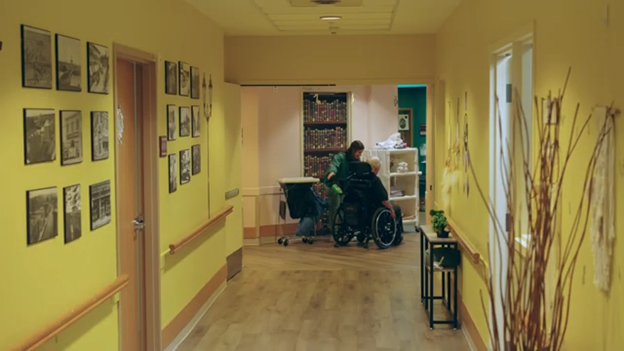
It Takes a Whole Team: Success Stories from the Butterfly Approach
Presenters: Sally Knocker & Lindsay Marinovic
Date: October 15, 2025

It Takes a Whole Team: Success Stories from the Butterfly Approach
Presenters: Sally Knocker & Lindsay Marinovic
Date: October 15, 2025

Mike Blackmore, Director of Long Term Care, Miramichi Lodge in Pembroke, provides an introduction in this short video clip (under 9 minutes) to the inspirational journey including the accreditation of the Lodge in implementing the Butterfly Approach to Care. Please take the time to watch it – click here:
 Image by the Elliott Community
Image by the Elliott Community
As reported in GuelphToday in June, the ‘Elliott Community becomes the first accredited Butterfly Home in Guelph’. This represents ‘a significant milestone in the organization’s journey toward delivering truly person-centred and emotion-focused care’. Click here to read

Until 2023, the Butterfly Approach had only been adopted in long-term care homes. Dr. Nadkarni shared Osler’s journey towards implementing the Butterfly Approach – a significant effort that involved not only a change to the model of care at Osler but also involved modifications to the physical space on the ACE Unit at the Brampton Civic Hospital.
For full recording, click here

In April 2025 Bankwood at the Glebe Centre received its third successful accreditation from Meaningful Care Matters. As noted in the Centre’s recent Family and Friends newsletter, the approach is centered on “delivering emotion-based focused care that connects with people in a dignified human way. It addresses the holistic needs of individuals and supports quality of life for each person living with dementia across the whole of lived experience.” Kudos to Glebe Centre and their Bankwood Care Team!

On Tuesday, March 18th, 2025, on CBC radio, The Current with Matt Galloway had a feature on “Putting Dignity at the Centre of Long-term Care”.
The broadcast includes interviews with a resident at Glebe Centre in Ottawa, Ontario and the resident’s daughter. Listen to this inspiring account of the importance of finding a residence that truly feels like home. Click here to listen to this broadcast (24 minutes).

A Green House Dining Room (copied with permission)
The National Institute on Aging released its recent report, “There’s No Place Like Home: Why Canada Must Prioritize Small Care Home Models in its Provision of Long-Term Care”.
“This report, There’s No Place Like Home, emphasizes the need for a transformative shift away from delivering care in large institutional care settings to smaller, more personalized, home-like environments that align with public preferences and improve care outcomes for residents and working conditions for staff. ”
Please join us in our advocacy efforts to transform Ontario’s long-term care homes from ‘institutions to homes’ by contacting your MPP and/or city councillor, writing a letter to the editor, etc to make this transformation happen.

In her recent book, A Physician in the Political Arena, Dr. Merrilee Fullerton
lays out her vision of what she had hoped for in reforming the long-term care home system in Ontario. Read more:
In Chapter 3 she writes, in part:
“Residents would have a dignified environment to live in. Physical, emotional and medical needs should be met…”
…”This underlines the importance of programs such as the Butterfly Model and the Eden Alternative Model that provide a more home-like setting with greater emphasis on emotional needs.”
Dr. Fullerton clearly saw the benefit of these innovative models of care that transformed their ‘institutions to homes’. Although at a snail’s pace, the numbers of these ‘homes’, in both the public and private sector in Ontario, continue to grow each year. We need to do more.
Click here to get involved. A draft letter is there for you to edit or send to your MPP or your local media. If we don’t begin to fix the long-term care system now, the residents will be forgotten yet again until another pandemic hits.

Judy Walters, behavioural support and butterfly lead at Pioneer Ridge Long-Term Care and Senior Services, says it’s important to keep in mind that long-term care homes are where residents live, not just where people work, when looking at how to make the space a more familiar environment.
(Sarah Law/CBC)
The Butterfly approach which has already been adopted in long-term care homes elsewhere in Ontario is now coming to Pioneer Ridge where it will be the first in northwestern Ontario to adopt this model.
“Pioneer Ridge Long-Term Care and Senior Services, which houses 150 residents across four home areas on Tungsten St., will be integrating the new care model into its memory and dementia care section over the next 12 to 18 months”. Click here to read more
We need to see more long-term care homes in Ontario move in this direction to change long-term care homes from ‘institutions to homes’. Please consider contacting your MPP or municipal councillor to advocate for this long overdue and much needed transformation in Ontario’s long-term care home system.

On June 19th, 269 persons registered for the webinar, “Recognizing diversity in LTC homes”. The 185 participants learned how the Rekai Centre in Toronto is serving their 2SLGBTQI residents.
The full webinar can be viewed here.

Presenter: Monica Goodban
Since 2018, Peel Region has been on a journey to change the culture of care in our homes, first through the implementation of Meaningful Care Matters’ Butterfly Approach in select home areas, as well as through the expansion of emotion-based care philosophies through our service areas and with our system partners. Join FCO and CARP Ottawa as we welcome Monica Goodban to share the full story. Q&A to follow.
Webinar recording from Jan 17th, 2024

Family Councils Ontario and CARP Ottawa welcomed Mary Connell on November 22nd from 12:00pm – 1:00pm to share about how Jarlette long-term care homes have rolled out the Butterfly approach, including the lessons learned, cost savings achieved and what current research is available.